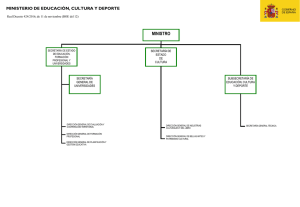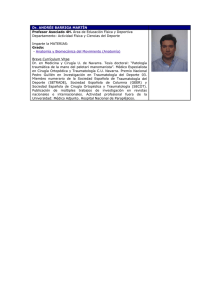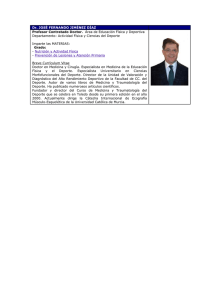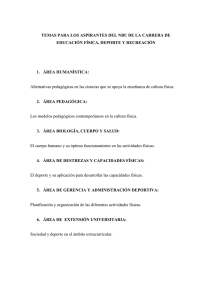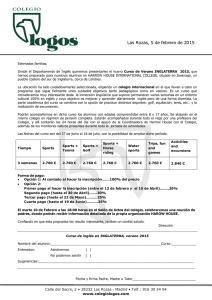Sports already occupied an important place in our society at the
Anuncio
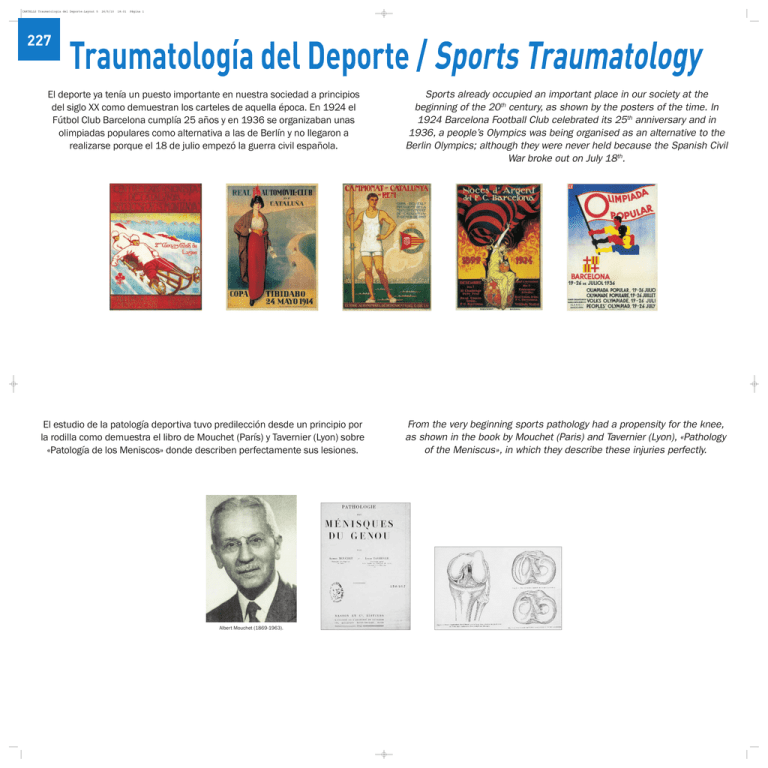
CARTELLS Traumatologia del Deporte:Layout 5 227 26/5/10 18:01 Página 1 Traumatología del Deporte / Sports Traumatology El deporte ya tenía un puesto importante en nuestra sociedad a principios del siglo XX como demuestran los carteles de aquella época. En 1924 el Fútbol Club Barcelona cumplía 25 años y en 1936 se organizaban unas olimpiadas populares como alternativa a las de Berlín y no llegaron a realizarse porque el 18 de julio empezó la guerra civil española. Sports already occupied an important place in our society at the beginning of the 20th century, as shown by the posters of the time. In 1924 Barcelona Football Club celebrated its 25th anniversary and in 1936, a people’s Olympics was being organised as an alternative to the Berlin Olympics; although they were never held because the Spanish Civil War broke out on July 18th. El estudio de la patología deportiva tuvo predilección desde un principio por la rodilla como demuestra el libro de Mouchet (París) y Tavernier (Lyon) sobre «Patología de los Meniscos» donde describen perfectamente sus lesiones. From the very beginning sports pathology had a propensity for the knee, as shown in the book by Mouchet (Paris) and Tavernier (Lyon), «Pathology of the Meniscus», in which they describe these injuries perfectly. Albert Mouchet (1869-1963). CARTELLS Traumatologia del Deporte:Layout 5 228 26/5/10 18:01 Página 3 Traumatología del Deporte / Sports Traumatology En los años 20 la práctica deportiva en Barcelona era muy importante y los accidentados eran asistidos en centros diversos sin criterio uniforme. A finales de esta década Emili Moragas ya tenía especial dedicación a estos lesionados, sobre todo los procedentes del fútbol. De acuerdo con la Federación Catalana de Fútbol se fundó la Mutual Deportiva de Catalunya y los tratamientos se centraron en unos especialistas y en una clínica. La revista France Foot se hizo eco en 1930 de la existencia de esta institución mutualista. En 1936 la experiencia en traumatismos del fútbol era de 3.500 casos clasificados y se preparó con este material clínico una comunicación que tenía que ser presentada en el Congreso de Médicos Deportivos que se organizó con motivo de las Olimpiadas de Berlín. Dr. Emili Moragas (1890). In the 20s, although sport was very widely practised in Barcelona, injuries were treated at different centres without any unified criteria. However, by the end of the decade, Emili Moragas was specialising in the treatment of these injuries, particularly football injuries. With the placet of the Catalan Football Federation, the Sports Mutual of Catalonia was founded and the treatments began to be centred on certain specialists and one clinic. In 1930, the magazine France Foot wrote about this mutual institution. By 1936 their experience in football-related traumatisms amounted to 3,500 classified cases, and with this clinical material a communication was prepared that was to be presented at the Congress of Sports Doctors, organised on occasion of the Berlin Olympics. Reglamento de la Mutual Esportiva de Catalunya presentado al Gobierno Civil para su aprobación. Regulations of the Sports Mutual of Catalonia presented to the state government’s regional office for approval. La Conselleria de Cultura del gobierno catalán patrocinó esta comunicación. The Department of Culture of the Catalan Government sponsored this study. En esta época el interés por la traumatología deportiva había propiciado la traducción de una obra de Mande sobre este tema a cargo de Ribó Rius, que había estudiado en Viena y trabajaba en el Hospital de San Juan de Dios en Barcelona. Puede que la primera monografía española sobre tema deportivo sea la de Alcalá Santaella de 1935. At this time, interest in sports traumatology had already led to the translation of a work by Mande on the subject by Ribó Rius, who had studied in Vienna and worked at the Hospital de San Juan de Dios in Barcelona. Perhaps the first Spanish monograph on the subject of sports was written by Alcalá Santaella, in 1935. El profesor Alcalá Santaella jugador de fútbol. Professor Alcalá Santaella, a football player. CARTELLS Traumatologia del Deporte:Layout 5 229 26/5/10 18:02 Página 5 Traumatología del Deporte / Sports Traumatology Entre los traumatólogos españoles ha habido en Barcelona dos especialistas deportivos que han destacado por su actividad asistencial y docente en este terreno: Juan Navés y Joaquín Cabot. Navés publicó en 1952 su libro pionero sobre Medicina del Deporte y Accidentes Deportivos, luego con Rubies Trias la monografía «La Rodilla» (la primera española sobre una articulación determinada) y finalmente su «Traumatología del Deporte». Organizó cursos de Traumatología Deportiva en la Clínica Plató de Barcelona. Amongst Spanish traumatologists, two sports specialists from Barcelona stood out for their healthcare and teaching activities in this field: Juan Navés and Joaquín Cabot. In 1952 Navés published his pioneering book on Sports Medicine and Sports Accidents. Later, with Rubies Trias, he published the monograph «The Knee» (which was the first Spanish monograph on a specific joint), and finally his «Traumatology in Sports». He also organised courses on Sports Traumatology at the Plató Clinic in Barcelona. Asistentes a un curso de traumatología deportiva de Joan Navés. Participants in a course on sports traumatology by Joan Navés. Joan Navés Janer. Joaquín Cabot Boix trabajó desde joven en la Mutual Médica al lado de Moragas y además consiguió en los años 50 el puesto de traumatólogo del F.C. Barcelona. Hizo su tesis doctoral sobre lesiones de los meniscos de la rodilla en 1951 y publicó con Navés, Moragas y Rocosa un manual para los masajistas del deporte. Posteriormente llegaría a Profesor Adjunto de Universidad y Jefe de Servicio de Cirugía Ortopédica y Traumatología. En el Hospital de Bellvitge desarrolló su labor docente con los cursos de patología de la rodilla. Cabot Boix explorando la rodilla de «César» Rodríguez, mítico jugador del F. C. Barcelona. Cabot Boix examining the knee of «César» Rodríguez, a legendary F. C. Barcelona player. El profesor Albert Trillat de Lyon en un curso de Navés. Professor Albert Trillat, from Lyon, in a course run by Navés. From an early age Joaquín Cabot Boix worked at the «Mutual Médica» along with Moragas, and later on, in the 50s, was given the post of traumatologist at F. C. Barcelona. He did his doctoral thesis on meniscus damage of the knee in 1951 and with Navés, Moragas and Rocosa, published a manual for sports masseurs. Afterwards he would become Assistant Professor at the University and Head of the Orthopaedic Surgery and Traumatology Department. He gave courses on the pathology of the knee at Bellvitge Hospital. Fútbol. Campeonato del Mundo. Río de Janeiro. Maracana VII-1950. Dr. Cabot Boix. Football World Cup, Rio de Janeiro. Maracana, July 1950. Dr Cabot Boix. Tesis Doctoral de Cabot Boix sobre los Meniscos de la Rodilla (1951). Cabot Boix's doctoral thesis on the Meniscus of the Knee (1951). CARTELLS Traumatologia del Deporte:Layout 5 230 26/5/10 18:02 Página 7 Traumatología del Deporte / Sports Traumatology Las publicaciones sobre traumatología del deporte son abundantes desde el último cuarto del siglo XX y muchas de ellas han sido traducidas, lo cual demuestra su aceptación entre los españoles. Estas obras pueden clasificarse en tres grupos: las de tipo general, las referidas a una determinada región anatómica y las propias de un deporte en especial. Entre las generales encontramos obras francesas, inglesas, suecas, alemanas. Publications on sports traumatology have been abundant since the last quarter of the 20th century and many have been translated, which proves their acceptance in Spain. These works can be classified into three groups: those of a general nature, those referring to a specific anatomical area and those related to a particular sport. Amongst those of a general nature we find works in French, English, Swedish and German. Entre las patologías regionales domina desde un principio la rodilla como demuestran los libros de Mouchet, Smillie, Navés, Trillat, Cabot y las escuelas que se han creado alrededor de esta articulación. From the very beginning, the most dominant pathology area has been the knee, as demonstrated by the works of Mouchet, Smillie, Navés, Trillat and Cabot, along with the schools created around this joint. CARTELLS Traumatologia del Deporte:Layout 5 231 26/5/10 18:02 Página 9 Traumatología del Deporte / Sports Traumatology Las monografías de un deporte en especial son variadas aunque el fútbol sea el deporte dominante. Monographs dealing with a specific sport are varied, although football is the dominant sport. Copa del Mundo de Fútbol 1994 (11-15 Junio) Conferencia Internacional 12 cirujanos europeos: Football World Cup 1994 (11-15th June) International Conference, 12 European surgeons: Paolo Aglietti (Italia), Pietro Debiase (Italia), Vjorn Ekblom (Suecia), Gregory Fox (Gran Bretaña), Werner Müller (Suiza), G. Naessens (Bélgica), Lars Peterson (Suecia), Thomas Reilly (Gran Bretaña), Tonu Saartok (Suecia), Lars I. Svenson (Suecia), Anders Valentin (Suecia), Giovanni Zacherotti (Italia). Otros/Others EE.UU. 36. La enseñanza de la Traumatología del Deporte ha llegado a la Universidad. En Barcelona empezó en el Hospital del Mar, asignado a la Universidad Autónoma, a cargo de Ramón Balius Juli y se creó además la Escuela Catalana de Traumatología del Deporte, que había iniciado sus cursos en 1979. Con motivo del VI Curso se le rindió un homenaje. La Universidad de Barcelona ha programado una Maestría (Master) de Traumatología del Deporte, dirigida por el Catedrático de Anatomía Ruano Gil y asistido por los profesores de cirugía ortopédica y traumatología de los hospitales docentes de Barcelona. Debemos añadir a estas enseñanzas las reuniones de la Sociedad Española de Traumatología del Deporte. Por encima de estas sociedades se sitúan actualmente los encuentros internacionales como el que se ha convocado en Gijón (Asturias) para noviembre del año presente. Ramón Balius Juli. The teaching of Sports Traumatology has reached the University. In Barcelona it began at the Hospital del Mar, assigned to the Autonomous University, headed by Ramón Balius Juli. The Catalan School of Sports Traumatology was also established, which began to impart courses in 1979. A tribute was paid to this organisation on the occasion of the 6th Course. The University of Barcelona programmed a Masters in Sports Traumatology, directed by the Professor of the Autonomous University Ruano Gil, assisted by the professors of orthopaedic surgery and traumatology of the Barcelona teaching hospitals. To these activities we must also add the meetings of the Spanish Society of Sports Traumatology. At a higher level, we find international encounters, such as the one to be held in Gijon (Asturias) in November of this year. CARTELLS Traumatologia del Deporte:Layout 5 232 26/5/10 18:02 Página 11 Traumatología del Deporte / Sports Traumatology Francia ha creado el Diploma Universitario de Cirugía del Deporte asignado a la Universidad «Pierre y Marie Curie» de París; se desarrolla en la Escuela de Cirugía en sus vertientes teórica y práctica y queda bajo el control de los especialistas de la Facultad de Medicina «Pitié-Salpétrière» y del Servicio del Profesor Saillant. France has established a University Diploma in Sports Surgery, assigned to the «Pierre and Marie Curie» University in Paris, where the theoretical and practical classes take place at the School of Surgery, under the control of the specialists of the School of Medicine «Pitié-Salpétrière» and the Department of Professor Saillant. En 1999 la Universidad Católica San Antonio, de Murcia, crea el título universitario de especialista de traumatología del deporte, bajo el notable empuje del doctor Pedro Guillén García. A este título se le adjudican dos años académicos de enseñanza, un examen final y un trabajo de final de carrera. A la par se funda para darle cobijo académico la Escuela Española de Traumatología del Deporte. En la primera promoción de 1999 se graduaron 36 alumnos. En el año 2006, cuando entra la 6.ª promoción, el título se transforma en Master Oficial de Traumatología del Deporte, adaptándolo a los acuerdos universitarios de Bolonia. Consta de dos años académicos, 90 créditos y siete módulos de formación. Hasta el momento presente ya se han formado en esta Escuela más de 140 alumnos. La Universidad San Antonio, ha creado la Cátedra de Traumatología del Deporte, que detenta Pedro Guillén García. In 1999, the Catholic University of San Antonio, Murcia, created the university title of sport traumatology specialist under the notable impulse of Doctor Pedro Guillén García. This title entailed two academic years of teaching, a final exam, and an end-of-course paper. At the same time, to provide an academic context, the Spanish School of Sport Traumatology was founded. In the first class of 1999, 36 students graduated. In 2006, when the 6th class entered, the title was changed to Official Master of Sports Traumatology, adapted to the university agreements of Bologna. The requirements consist of two academic years, 90 credits, and seven training modules. Up to the present day, this school has trained more than 140 students. The University of San Antonio has created the Professorship of Sports Traumatology, at present held by Pedro Guillén García. CARTELLS Traumatologia del Deporte:Layout 5 233 26/5/10 18:02 Página 13 Traumatología del Deporte / Sports Traumatology Nuestra sociedad de consumo ha descubierto que el deporte puede ir más allá y encontrar placer en desafiar el riesgo y gozar de la aventura, como en los casos de tirarse de un puente, volar con alas delta o parapente, descender barrancos, escalar paredes de montañas, descender al fondo de cuevas. Los accidentes obligan a poner en marcha sistemas de socorrismo complejos y costosos: bomberos, cuerpos de montaña, ambulancias medicalizadas, helicóptero. La sociedad paga del presupuesto público estos rescates que exceden enormemente de las primitivas responsabilidades de las Mutuas de Accidentes del Deporte. Our consumer society has discovered that thanks to sport, we have learned to find pleasure in defying risks and enjoying adventures, such as bungee jumping, hang gliding or paragliding, canyoning, climbing or caving. The resulting accidents meant the establishment of complex and costly rescue systems: specialists from the fire department, mountain patrols, medically-equipped ambulances and helicopters. Society uses public funds to pay for these rescue services, which are vastly in excess of the original, limited responsibilities of the Sports Accidents Mutual Benefit Societies. DANGEROUS MOUNTAINS Rescue missions carried out between July and September. The data for 1996 refer to the missions carried out between 1st January and 18th July. (1) Hang-gliding, (2) Canyoning, (3) Skiing, (4) Caving, (5) Climbing, (6) Avalanche, (7) Paragliding, (8) Search, (9) Rescue, (10) Transfers to shelter, Others. The number of missions to rescue mountaineers is much higher in summer months than during the rest of the year. There has been a progressive increase since 1993. The popularization of adventure sports has meant an increase in the number of people in high country and mountains, but they are not always properly prepared or experienced. In 1995, fourteen people lost their lives in the mountains, climbing, canyoning, or doing other adventure sports This year (1996) to date, there have already been 31 deaths due to these activities. Source: Generalitat de Catalunya Fire Department.
